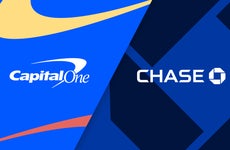Chase Freedom Unlimited vs. Capital One Quicksilver

The Bankrate promise
At Bankrate we strive to help you make smarter financial decisions. While we adhere to strict , this post may contain references to products from our partners. Here's an explanation for . The content on this page is accurate as of the posting date; however, some of the offers mentioned may have expired. Terms apply to the offers listed on this page. Any opinions, analyses, reviews or recommendations expressed in this article are those of the author’s alone, and have not been reviewed, approved or otherwise endorsed by any card issuer.
Key takeaways
- The Chase Freedom Unlimited® and Capital One Quicksilver Cash Rewards Credit Card are no-annual-fee cash back cards that could fit well into many lifestyles and wallets.
- Both cards play well within their issuer’s respective rewards programs, meaning whichever rewards cards you already have could point you toward either the Freedom Unlimited or Quicksilver.
- Additionally, both cards offer strong introductory APR terms that could help you pay off existing debt or finance a large purchase over time.
The Chase Freedom Unlimited® and Capital One Quicksilver Cash Rewards Credit Card may seem similar due to their non-category rewards rates and $0 annual fees. But dig deeper, and you’ll find quite a few differences between these two cash back credit cards — and perhaps even a reason to choose one over the other.
If you have to pick just one, we would be inclined to suggest the Chase Freedom Unlimited due to its added rewards categories, the flexibility of the Chase Ultimate Rewards program and additional insurance protections you receive. However, the Capital One Quicksilver Cash Rewards Credit Card offers a better welcome bonus while also including flexible redemption options and an assortment of travel and purchase protections.
Keep reading to learn more about the main perks of these two rewards credit cards and how they stack up against each other.
Main details
| Chase Freedom Unlimited | Capital One Quicksilver Cash Rewards Credit Card | |
|---|---|---|
| Welcome bonus | Earn an extra 1.5% cash back on all purchases (up to $20,000 spent) the first year — worth up to $300 in cash back | $200 cash bonus after spending $500 on purchases within the first 3 months |
| Rewards rate |
|
|
| Intro APR |
|
|
| Annual fee | $0 | $0 |
| Foreign transaction fee | 3% | None |
Chase Freedom Unlimited vs. Capital One Quicksilver highlights
Let’s take a closer look at the main highlights of the Chase Freedom Unlimited and Capital One Quicksilver to determine which one might be most useful for your wallet.

Chase Freedom Unlimited
-
The Capital One Quicksilver offers an easily-attainable $200 cash back bonus after spending $500 during the first 3 months after opening your account. The offer is a traditional welcome bonus with clear terms and a fixed reward for meeting those terms.
On the other hand, the Chase Freedom Unlimited offers an additional 1.5 percent cash back on all purchases your first year. The bonus rewards are capped at $20,000 in spending, which makes the welcome offer worth up to $300. Because the Freedom Unlimited offers the potential to earn a higher welcome bonus, it wins this category.
However, if you do the math, you’ll realize that you need to spend the full $20,000 the first year in order to earn the Freedom Unlimited’s full $300 bonus. To meet the $200 bonus offered by the Capital One Quicksilver, you’d need to spend about $13,334 over the first year. Since the Capital One Quicksilver only requires you to spend $500 during the first 3 months to earn its $200 bonus, you’ll have a much easier time earning the welcome bonus with this card.
If you don’t think you’d spend more than $13,334 on the Freedom Unlimited in a year, you’d be better off with the Quicksilver.

Chase Freedom Unlimited
-
While both cards offer the same 1.5 percent back for each dollar you spend, the Chase Freedom Unlimited’s myriad of additional rewards categories make it the overwhelming winner in terms of rewards rate potential — and that’s not even including its pairing ability with other Chase credit cards.
The cash back earned by the Chase Freedom Unlimited comes in the form of Chase Ultimate Rewards points. So, if you want to redeem rewards for travel, for example, you can pair the Chase Freedom Unlimited with the Chase Sapphire Preferred® Card or Chase Sapphire Reserve®. You can then pool your rewards in your Sapphire account to unlock redemption options and boost your points by 25 percent or 50 percent when redeemed for travel through the Ultimate Rewards portal, respectively.
Pooling your points in a premier Chase card account like the Sapphire Preferred or Reserve also makes it possible to transfer your points 1:1 to Chase airline and hotel partners, which can help you glean even more value for your rewards. Keep in mind the Chase 5/24 rule and how it might affect your ability to qualify for multiple Chase cards over a short span of time.
It’s also worth noting that if you have a Capital One travel credit card (such as the Capital One Venture X Rewards Credit Card), you can also turn your Capital One Quicksilver’s cash back into miles at a 1 cent:1 point ratio and redeem for travel bookings. Keep in mind, however, that Bankrate values Chase Ultimate Rewards points slightly higher than Capital One miles — with Chase points worth up to around 2.0 cents apiece, while Capital One miles are worth up to around 1.7 cents apiece.
Tie
-
Both credit cards offer a 0 percent introductory APR on purchases and balance transfers for 15 months. Even after the 15 months are up, the variable APRs that will kick in are still very similar: 20.49 percent to 29.24 percent for the Freedom Unlimited and 19.99 percent to 29.99 percent variable for the Quicksilver.
However, the cards do differ when it comes to balance transfer fees. The Quicksilver charges a pretty standard 3 percent fee on transferred balances for the first 15 months, whereas the Freedom Unlimited charges an introductory 3 percent fee ($5 minimum) for balances transferred within the first 60 days. If you wait to transfer your balance after 60 days, the fee jumps to 5 percent ($5 minimum).
Tie
-
When it comes to important credit card fees, this comparison also ends in a draw. Neither card carries an annual fee, making both cards a good option for those looking to skip the yearly payment.
Credit cards with no annual fee are especially helpful for those who don’t spend a lot on their cards but still want to earn something in return.

Capital One Quicksilver
-
On your next trip abroad, you’ll want to pack the Capital One Quicksilver instead of the Chase Freedom Unlimited. The Capital One Quicksilver card doesn’t charge any foreign transaction fees, while the Chase Freedom Unlimited charges a 3 percent fee on each purchase made outside of the United States or in a foreign currency.
Which card earns the most?
The Chase Freedom Unlimited and the Capital One Quicksilver come with similar fees and benefits, but how do the ongoing earnings on these cards compare?
Chase Freedom Unlimited vs. Capital One Quicksilver spending example
Let’s say you spend the following in a month with either card:
- $500 on hotel travel booked through your card’s portal
- $200 on dining
- $150 on everything else
With the Chase Freedom Unlimited, you’d earn $25 in cash back on hotel travel purchases, $6 in cash back on dining and $2.25 on all other non-category purchases, for a total of $33.25 in monthly cash back earnings. That’s $399 in cash back if you repeated this spending for an entire year.
Using the Capital One Quicksilver, on the other hand, you’d earn $25 in cash back on hotel purchases, $3 in cash back on dining and $2.25 on everything else, for a total of $30.25 in monthly earnings. That would be $363 in cash back earned for the year, which is $36 less than you would earn with the Chase Freedom Unlimited.
Of course, in this example, we’re not highlighting the additional rewards you would earn from any drugstore or Lyft spending — meaning the already higher-earning Chase Freedom could earn you even more rewards. Furthermore, this example doesn’t account for Ultimate Rewards points possibly being worth more when redeemed than rewards earned with Quicksilver.
Why should you get the Chase Freedom Unlimited?
The Chase Freedom Unlimited is worth it for many everyday spenders as it offers solid earning potential, including 1.5 percent cash back on non-category purchases, and a decent first-year welcome offer. However, there are a few more reasons to pick this card.
Additional benefits
With the Chase Freedom Unlimited, you’ll receive purchase protection that covers new items against damage and theft, as well as extended warranty protection that adds an additional year to many U.S. manufacturer warranties. You’ll also receive trip cancellation and trip interruption insurance, auto rental insurance and roadside assistance.
In terms of partner offers, you can enjoy a complimentary 3 months of DashPass, a subscription service that offers $0 delivery fees on DoorDash orders over $12 (when you activate by Dec. 31, 2024). Don’t forget, you can also earn 5 percent cash back on Lyft rides through March 31, 2025.
For a full list of everything the card has to offer, consider reading our Chase Freedom Unlimited benefits guide.
Redemption options
The rewards you earn with the Chase Freedom Unlimited are redeemable for the following:
- Cash in the form of a statement credit or direct deposit
- Travel booked through Chase Ultimate Rewards
- Gift cards
- Shop with your rewards on Amazon.com
- Charitable donations
- Points you can combine with Ultimate Rewards from a premium Chase card to transfer them to travel partners
Recommended credit score
A good to excellent credit score of 670 or above is recommended.
Why should you get the Capital One Quicksilver?
The Capital One Quicksilver appeals to much of the same audience as the Chase Freedom Unlimited due to its lack of an annual fee, achievable welcome bonus and same base flat rewards rate. However, there are a few reasons why the Quicksilver may be more worth it for you compared to the Freedom Unlimited.
Additional benefits
Besides not paying a foreign transaction fee for purchases made abroad, the Capital One Quicksilver offers travel accident insurance and other travel coverages through Mastercard. You can also enjoy extended warranty protection at no charge on eligible items purchased with your credit card and purchase protection in the case of damage or theft.
Plus, Quicksilver cardholders receive up to six months of complimentary Uber One membership (formerly Uber Eats Pass) through Nov. 14, 2024. This perk has the potential to save you around $60 in membership fees.
For a more in-depth look at the card’s offerings, read through Bankrate’s Capital One Quicksilver Card benefits guide.
Redemption options
Capital One Quicksilver rewards can be redeemed in a few different ways:
- Cash back in the form of a statement credit or check
- Cover recent purchases
- Travel through Capital One’s portal
- Pay with rewards on Amazon.com or via PayPal
- Gift cards
- Points you can combine under miles-earning Capital One cards and transfer your rewards to travel partners
Recommended credit score
You should be able to qualify for the Capital One Quicksilver if your credit rating is good to excellent (around 670 or higher).
The bottom line
The Chase Freedom Unlimited and Capital One Quicksilver Cash Rewards Credit Card are both ideal for those looking to earn at least 1.5 percent cash back on every purchase — and for no annual fee.
The Chase Freedom Unlimited pulls out slightly ahead due to its added rewards categories and potential for more flexible redemption options, but only you can decide which card works better for your financial needs and goals. If you’re already collecting rewards in the Ultimate Rewards or Capital One miles universes, you may want to stick with the card that will allow you to continue to add rewards to that pool.
Of course, before you make your choice and apply, consider reading through Bankrate’s list of the best cash back credit cards on the market.
Related Articles




Capital One Quicksilver Cash Rewards vs. Bank of America Unlimited Cash Rewards